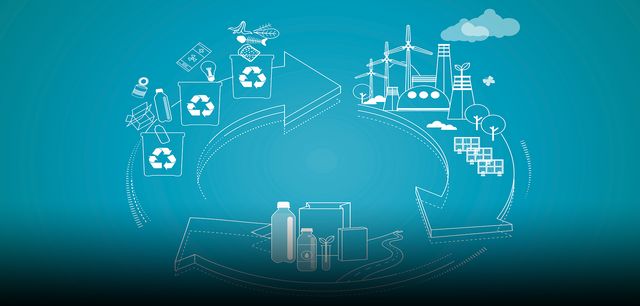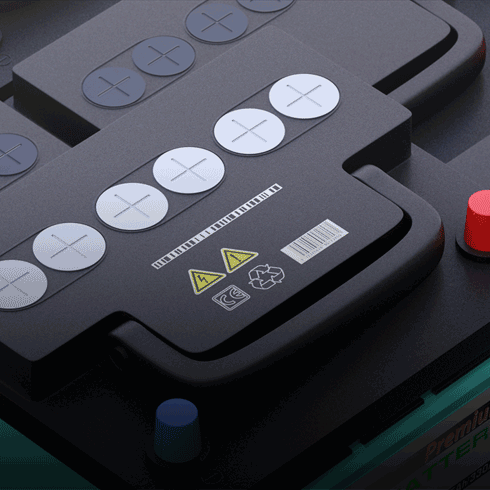25. March 2021
With products ranging from coffee capsules made from renewable raw materials, and disposable dishes from plant waste to electric car batteries with raw materials from their discarded predecessors, more and more companies are seeking to move away from waste. Politically, too, more and more attention is being paid to the circular economy. In France, disposable plastic products will soon be a thing of the past, and new life is to breathed into the practice of repairing things.
Since the dawn of the industrial revolution, the economy has mainly functioned according to a linear model. Products, packaging and food are produced at high energetic cost and end up in landfill after what is often a fairly short life. The European Parliament wants to replace the mechanisms of the throwaway society with an ever more seamless circular economy. Existing materials and products should be used, shared, repaired, reused, reprocessed and recycled for as long as possible. In 2018, the EU adopted new targets to promote reuse and recycling, reduce packaging waste and limit the amount of waste that can still be dumped in landfill sites.
In terms of their actual implementation, the member states have shown varying degrees of resolution. Germany passed laws to set a target for the circular economy as early as 1994. The main focus was on energy efficiency and recycling, and the Federal Republic of Germany is still playing a leading role here today. The recycling of PET bottles is progressing particularly well, boosted by the deposit on disposable bottles that was introduced in 2006. 93 percent of all plastic bottles were recycled in 2019, according to a study by the German Society for Packaging Market Research (GVM). Particularly pleasing in terms of the circularity principle is the fact that nearly 38 percent of recycled material is turned into new plastic bottles – five percent more than in 2017. On average, according to the study, almost 30 percent of every PET bottle in Germany is made of recycled material. In 2017, it was 26 percent. This means that the EU directives for 2030 are already being complied with.
“Law against waste”
In terms of the proportion of plastic packaging waste recycled, Germany was above the EU average of 41.5 percent in 2018. However, the frontrunner, Lithuania, can boast a figure of 69 percent, whereas Malta is languishing at the rear with just 19.2 percent. France came in second to last, at around 27 percent. The Grande Nation now wants to significantly increase its recycling rates in the coming years, while at the same time setting new standards in waste prevention.
Since 2016, French supermarkets have been obliged to donate unsold food. The law against waste (“loi anti-gaspillage”) adopted in 2020 is now intended to drastically reduce the amount of waste generated in the country and to promote the circular economy. Disposable plastic products are gradually being phased out and waste prevention and reuse promoted, and the production of environmentally friendly products is being encouraged by the introduction of a bonus-malus scheme.
Disposable plastic dishes have not been sold in France since 2020, and plastic water bottles have been barred from school canteens ever since. Earlier this year, disposable knives, forks, coffee cup lids and plastic confetti were also banned from supermarkets and cafes. With these regulations, France is in some ways going above and beyond an EU directive banning straws, cotton swabs, stirrers, plates and cutlery made of plastic, and polystyrene food containers from this summer. But the French government does not just have plastic waste in its sights: as of 2022, it will no longer be legal to destroy clothes and hygiene items which fail to find a buyer. They will have to be either donated or recycled. From 2023, till receipts for small sums will be abolished, unless customers explicitly ask for them.
Consumers in France will also in future be given better information about the environmental performance of certain products. Since the beginning of 2021, manufacturers of electrical appliances have had to provide a repair index for their washing machines, smartphones, laptops or televisions. Buyers can see at a glance how easy or difficult it is to repair the device in question. The government’s aim here is to prevent 60 percent of the devices from being thrown away when they develop a fault, as is currently the case.
© iStock93 percent of all PET bottles in Germany were recycled in 2019.
Back to the cradle
The circular economy is, of course, not only being driven by the policymakers. BMW, for example, recently announced that it would convert its car production to become more environmentally friendly. Recycling considerations will in future be included in the design of the vehicles. To reduce the consumption of raw materials, the car manufacturer is aiming for a paradigm shift: secondary materials such as recycled steel, plastic or recycled aluminium should be used in preference where quality requirements permit. In this way, the Bavarian auto giant aims to produce the “greenest electric car” in the world.
But various environmental associations and initiatives are also promoting the environmentally friendly circular model. The Cradle-to-Cradle movement is committed to the particularly uncompromising implementation of the circular economy. The aim of the concept developed at the end of the 1990s is to produce goods in such a way that they can be biodegraded after use and returned to the natural material cycle as “nutrients” or be reprocessed into new products without any loss of quality. A compostable T-shirt from C&A, a felt pen from Stabilo and a bath cleaner from Frosch have already been certified according to the C2C standard.
Nor is it enough for cradle-to-cradle products just to be harmless to people and the environment: they should even be of positive benefit to them. One good example is that of buildings festooned with lush greenery, whose plants allow insects to thrive and which at the same time improve the climate in the city – as in the Dutch town of Venlo. The town hall there is made entirely of recyclable materials, and its green facade filters fine particulate matter out of the air within a radius of 500 metres. Inside the building, the air is additionally purified by a large greenhouse, making the employees healthier – the number of sick days has significantly decreased.
Environmentally friendly in Essen
To date, 25 construction projects in the Netherlands have been inspired by the cradle-to-cradle idea. In Germany, the administration building of the former coal giant RAG in Essen has taken its own first steps. On the green roof of the former Ruhrkohle AG, employees can take a stroll or do some work, and insects and bats wheel and whirr through the air. Solar systems produce electricity and provide shade. Inside, geothermal energy ensures pleasant temperatures in both summer and winter. The toilets in the building and the plants on the roof are supplied as far as possible with rainwater.
TÜV NORD's new HQ in the Essen Technology Park is also based on the cradle-to-cradle principle. Plants grow on the roof. Building materials made of steel, wood and aluminium were recovered as far as possible from the previous building. Around 80 percent of the concrete and masonry from the demolished building was reused, and the recycling and disposal of all the materials used was taken into account in the planning. The building is kept warm by low-carbon district heating – compared to conventional gas, this saves around 36 tonnes of CO2 per year.
From the outside, the ecological soundness of the RAG and TÜV NORD buildings is not evident to the casual observer. Things are very different with “The Cradle” in Düsseldorf, whose name attests to the principle behind its construction. The facade of the special office building will mainly consist of wood, which could one day also be made available for use in another house or for furniture. The interior of the building, planned for 2022, will make use of pollutant-free and recyclable materials to provide its future users with a healthy and pleasant working atmosphere.
Affordable and health-friendly housing is also promised by a construction project for Hamburg's HafenCity which goes under the name of “Moringa”. The first cradle-to-cradle residential high-rise in Germany will house 190 rental apartments and consist of at least 50 percent recyclable materials: Plants will snake up the outer walls. The facade elements are to be made of wood or ceramic materials, and the walls will consist of clay. The roof will be a meadow with urban gardening allotments. When both horizontal and vertical development are included, more green space will be created than built over on the ground. If everything goes according to plan, this green high-rise with its views of the Elbe will be ready for occupancy in 2024. And it might then even inspire other project developers to integrate circular ideas into their plans.



